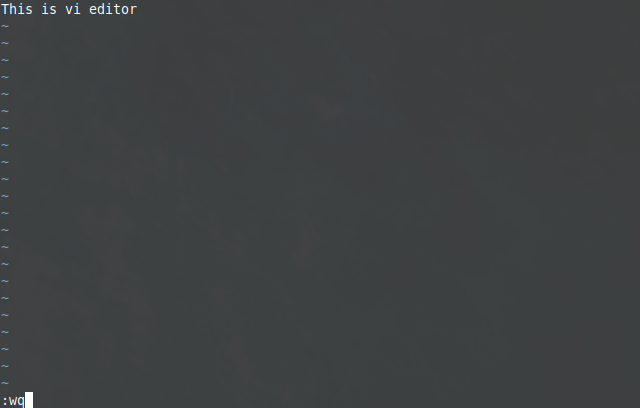Introduction to vi
Vi is a command based & standard Unix text editor. It is fast and powerful you need not remove your fingers from your keyboard while editing a file in it. It has short commands to manipulate the text. And it is available for nearly all Unix like operating systems. Originally it was developed by bill joy in 1976. Later various versions are released with improvement in it.
Starting vi in your terminal
1. Open your terminal
2.Type vi filename.txt
- If filename.txt exist in your system it will open with the content in it
- Otherwise, it will create a new file with the name filename & .txt extension
and opens in your terminal for editing
Vi Operating modes
So before start using vi as your text editor you should have some basic understanding of how it operates in different modes. The editor operates in the following two modes –
1. Command mode
- It is the default mode of the editor and when you first start a file in vi it opens in command mode
- In this mode commands are given to accomplish different operations on files like moving the cursor around text, deleting text, saving the content of the file, etc.
- vi commands are case sensitive that means you can’t use uppercase letters
instead of lowercase and vice versa.
2. Text or Insertion mode
- This is the mode in which every character typed is added into the file
- You can go into insert mode in many ways but have to exit with
<esc>key
Moving cursor around text
You can use the following keys to move the cursor around the text. So before using these keys in vi to navigate around the text you will have to go into command mode.
Use the keys in command mode
| Command | Description |
|---|---|
k | Move one line up |
j | Move one line down |
h | Move one character left |
l | Move one character right |
b | Left one word |
w | Right one word |
0 | Move the cursor to the beginning of the current line |
$ | Moves cursor to the end of the current line |
Note: On some Unix or Unix based platforms arrow keys are allowed to use for moving the cursor around the text
Entering, modifying and changing text
The following keys or combination of keys can be used to enter, modify or change the inserted text
Use these keys in command mode
| Command | Description |
|---|---|
i | Start text entry mode |
x | Delete one character |
dd | Delete a line |
dw | Delete a word |
r | Replace a character |
R | Overwrite text |
Exiting vi
Once you are done writing, reading, or modifying a file in vi you can exit by using the following combination of keys. And before that, you have to activate command mode for vi. And you just have to press enter after the commands starting with a :(colon)
Use these commands in command mode
| Command | Description |
|---|---|
ZZ | Write(if changes are made) then quit |
:wq | Write, then quit |
:q | Quit(work if there are no changes made in the file) |
:q! | Quit without saving the changes that are made into a file |
Searching, copying and pasting text in vi
Use the following in command mode
| Command | Description |
|---|---|
/string | Search forward (top to bottom) for text |
?string | Search backward (bottom to top) for text |
yy | Copy the current line |
5yy | Copy 5 lines begin with the current line |
p (in small) | Paste that text after the cursor position |
P (in capital) | Paste that text before the cursor position |
Set line number and wrap margin in vi
Some time it is very useful to using line number while writing text
Use in command mode
| Command | Description |
|---|---|
:set nu | Will displays the line number |
:set nonu | Will hide line number |
:set wm=n | Set the margin n spaces from the right side of the screen |
:set wm=0 | Turn off the wrap margin |
Manipulating editor screen in the terminal
You can use the following window commands in vi editor to move up or down screen several times
Use in command mode
| Command | Description |
|---|---|
ctrl+f | Moves forward one screen |
ctrl+b | Move backward one screen |
ctrl+d | Move down (forward) one half screen |
ctrl+u | Move up (back) one half screen |
ctrl+l | Redraw the screen |
ctrl+r | Redraw the screen, removing deleted lines |
Using vi editor
1.Open terminal type vi filename.txt
![]()
2. Now the file is open in command mode press i and start writing your text

3. You are currently in insertion mode press <esc> to switch to command mode Save Now press ZZ or:wq and enter to save the file.

Now it will return to the terminal by saving the contents of the file. I think the list of commands given above in the article is sufficient to start with it. You should try the commands on your own system so that you get more familiar with it.
